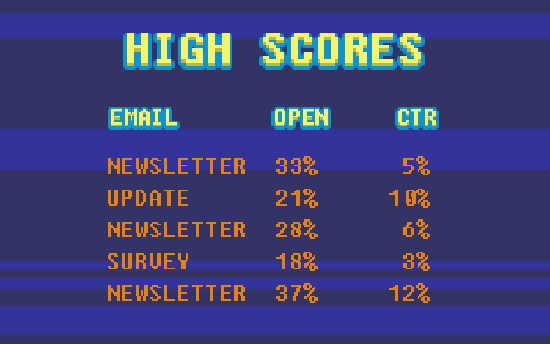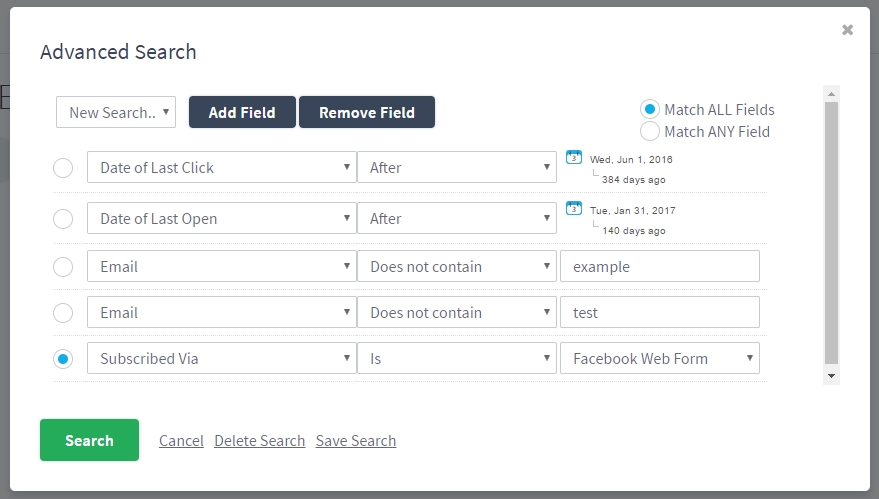In the world of email marketing, your email list is one of your best assets. But managing it effectively feels like one big game. And it’s addictive. We’re segmenting, optimising, and personalising each email campaign to achieve a higher score. And whether you’re winning or losing, you always find yourself ready for another round. Being in competition with yourself means a relentless drive to set some new records. So to help you nail your next high score, here’s my favourite 3-hit combo.
Take some time to read the instructions
Here’s a shocker. Quantity isn’t my biggest priority anymore. Put the controller down for a second because you’ll need all of your fingers for this next task. Let’s work out the math for just a sec. The ideal open rate is 100%. It’s not realistic, but it’s the Holy Grail. But when I send to my entire list, according to the latest Metrics Report, I should expect to achieve a 30% open rate.
Ok, so why are 70% of people who’ve given me their email addresses ignoring me? Well, there are lots of reasons, so I’m not going to start making things up. But what if I started changing and reorganising the people on my email list into different groups? Think of it like organising your players and teams to make sure you’ve got the advantage every time. There are unlimited ways to slice your email list, but it’s a bold move that comes with a big payout.
We have a lot of power to segment and manage our data in ways that give us more accurate and insightful information. Think of things like demographics, geography, industry, past purchases or even email engagement. Segmentation can be really rewarding and I know I’m always excited to watch my open rates rise as I target a more active and engaged audience. Most email platforms include exciting segmentation features, so take advantage of what’s built right into the game, read the instructions, and understand the rules to set yourself up to win.
Level-up by understanding the players
Are you ready to take your email marketing game to the next level with unprecedented click-through-rates (CTRs)? Try getting to know your customers better by asking them questions. Guessing is for chumps, so consider putting together a quick customer survey. You can ask them about what they’d like to see more of, what their interests are, what’s bothering them or where they look for information or inspiration. All those extra points add up quick when you’re growing an email list.
Then feed these survey results back into your list. It’s data that you can use to segment, test, and leverage to create more targeted campaigns. By removing the guesswork, you’ll figure out the perfect formula to deliver even more relevant information to your readers at the right time. It’s a power move that’ll open up a lot of combinations to take your email game to the next level. As a bonus, try using those built in segments to create surveys for high and low-response subscribers.
No one likes a rage quitter
So we’re still not going to achieve a perfect open rate. But what do we do with those people that still aren’t opening our emails? Well, we’ve got to accept that we’re not going to win every time. Playing a good email game means trusting in the process that will help you break your existing high score records, even when it feels counter-intuitive. Email requires a long-term game strategy.
In the case of a re-engagement or sunsetting policy, eliminating the dead weight from the database produces healthier metrics. When creating policy, don’t be too aggressive. I know it can be a blow to the ego when people ignore you. But it’s important to remember that although removing unengaged subscribers is a graceful way to keep your database fresh and clean, once they’ve been removed it’s permanent until they choose re-subscribe. Think conservatively when starting to define the amount of time required before being blacklisted and branded as unengaged.
It makes a lot of sense to stop communicating to people that don’t care because they will skew your awesome results. Fewer bounces and spam complaints are an added benefit. But remembering that readers are humans just like you and I, who are overwhelmed by the barrage of companies constantly competing for their attention. Non-opens don’t always mean someone’s on their way out, so be sure to give them enough time to choose to read your emails again.
Own it and take control
Once we know who’s on our list and what they like, it’s time to accept that one size doesn’t fit all. Email marketing is no longer about bulk sends and hope. It’s about figuring out how to send a message that seems tailor-made for an individual rather than a crowd. And to do this you’ll need to figure out the customer journey and get really good at recognising where your audience is sitting in the buying cycle. After all, it makes sense that subscribers who have just signed up for your newsletter need different messages than people who abandoned their shopping carts.
Like any good game, you’ve got to memorise the moves and recognise the patterns. Start looking into behaviours that you can target specifically, over and over to send your game scores through the roof. By having a closer look at what’s ringing your readers’ bells, you’ll be able to confidently figure out what they like and what they don’t. Although you can’t see your readers’ physical reaction to your latest email, you can certainly learn a lot by simply watching and memorising how they move.
And try expanding past just email data and plug website behaviour into the mix too. By looking for more clues about what content people interact with – like which pages they visited, time spent on page, videos watched, and more, you can beef up your email list and create automated email campaigns to continue the conversation and convert your prospect into a customer time and time again.
—








